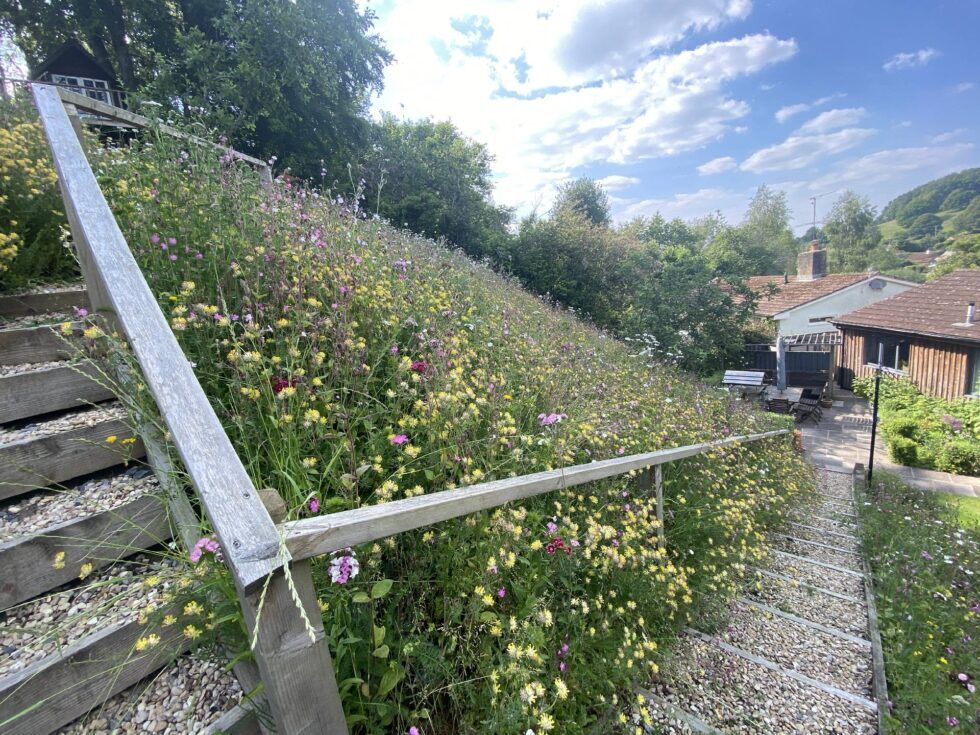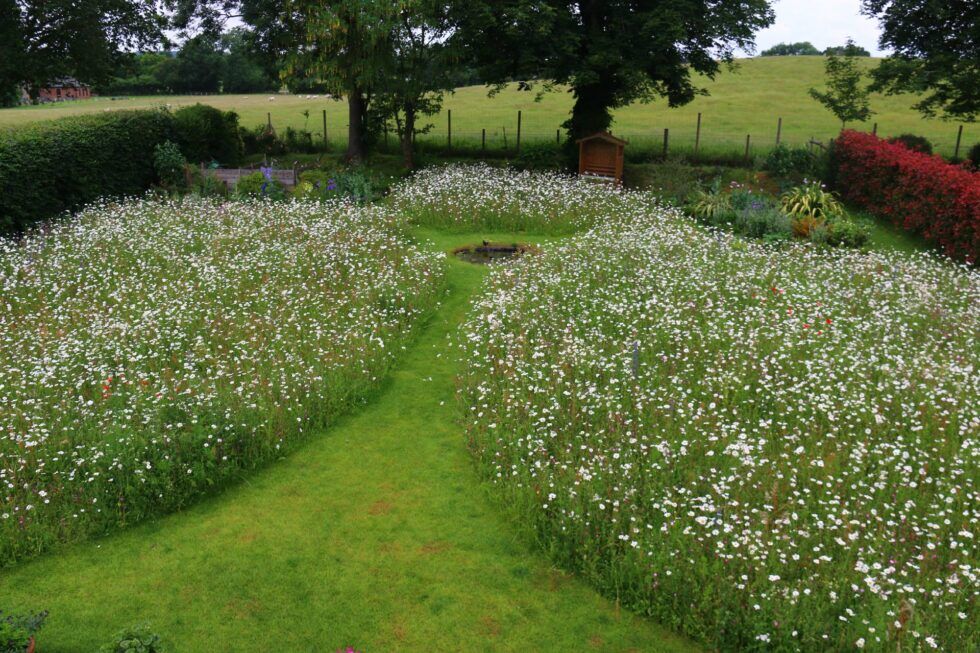With the RHS Chelsea Flower Show just around the corner, now is a good time to put the spotlight on Garden Design. World-renowned as a showcase for innovation and setting new trends, the Chelsea show is a springboard for garden designers to launch their careers on the back of spectacular showpieces. Sometimes these designs are a little bit leftfield, but at the same time there are many elements that have made their way into our real-world gardens. It is a show which always provides inspiration in shed loads, and in this article we take a look at some basic principles which can help us all make the most of our garden spaces, whatever their size.
To lawn, or not to lawn?
In recent weeks, we’ve published blog posts on two subjects which are controversial in our industry: ‘Do we really need lawns?’ and ‘Is an artificial lawn a good thing?’. Naturally, as lawn care specialists we would always advocate some area (or areas) of lawn should be included in any garden layout. As you’ll see in those articles, the benefits of having a lawn in our gardens are wide ranging so we believe there should be some natural grass in every garden.
Gardens, like everything else, have evolved over the years and now there seems to be no limit on what can be used in a garden setting. Whether your taste is traditional or contemporary, there is plenty of inspiration around to help you make the most of your garden space.
WHERE TO START
Decide on what you want, need and are prepared to spend.
Why not turn to the TV or internet for inspiration? Digital TV is awash with garden transformation shows and there is a wealth of information online, both in video and written forms. Your favourite TV Garden presenters and a whole other world of experienced experts have made their knowledge accessible to everyone, free of charge so we can all plan our own gardens without necessarily consulting a designer. Do some research and cherry-pick the elements that catch your eye. A garden layout can get off the ground and take shape around the tiniest of details, when they’re used as design cues. For example, on TV garden makeover shows we’ll often hear a homeowner say they want a garden which reminds them of the Mediterranean. The designers will usually respond with plenty of hard landscaping in pale natural stone and plants like Olive trees or Canary Island Date Palms. They’re also quite likely to add colourful glazed tiles to a wall around a patio area, to reinforce the theme.

Mediterranean influences in a courtyard garden.
These design cues can also be much more specific, like a finishing detail which catches your eye and makes you think “I fancy that in my garden”. A detail which elsewhere might be considered a finishing touch, like a stylish mirror or piece of sculpture, can set the blueprint for a whole garden to be built around.
Mood Boards

Mood Boards are a great way to bring together all those little ideas which have caught your eye and keep them in one place.
Before you even start with a clean sheet of paper, consider putting together a Mood Board. Many people use them when decorating a room in their homes, and this can be just as effective when it comes to gardens. Before the digital revolution, this would involve scouring magazines, newspapers or books and cutting out pictures of items or even whole rooms which have been inspirational, to form a visual impression of how their own finished space will look. In this form, they are still fabulous tools as they give us a tactile picture to work with. On the other hand, 21st century digital tools enable us to pull all of these inspirational components together and carry them around with us wherever we go. This really comes into its own when we are away from the garden, or when meeting suppliers and contractors. Whichever way works best for you, a mood board can be a truly inspirational way to focus your creative energy as your new garden takes shape. This early stage is also the perfect time to ask yourself a fundamental question: ‘Who will this garden be for?” It may sound a little odd for the garden’s owners and creators to be asking this of themselves, but not everyone will be making a new garden solely for their own use. Do you have children, or grandchildren who will be using the garden? Will they need some lawn to play on, or even a structured playground of their own with permanent apparatus? Maybe even a treehouse or Wendy house might be called for. Equally, you may have pets with their own needs to consider. On another level, who will be maintaining the garden once it’s been built? Are you planning to take care of the plants, lawn and general maintenance yourself or will you be engaging professionals? It’s a good idea to bear this in mind as you’re putting it all together, as your design may look fabulous on paper but end up being a nightmare to nurture for anyone but an expert! Think also about the longevity of everything you put into the garden, and how you might store or cover certain items. For instance, there’s nothing that says ‘neglect’ like garden furniture that has been left uncovered outside for a couple of winters. If you include everything in your maintenance plan, it will reward you with years of pleasure.
The fresh sheet of paper (or blank screen)

Not every design begins with a blank sheet of paper!
When setting out on your garden design journey, take the time to decide exactly what your wants, needs and expectations are. Here are a few pointers to consider…
Does the property belong to you? If you’re renting, are there limitations on what you can or cannot do with the garden? How much money, time and effort do you want to commit to making over a garden which does not belong to you? What does your landlord expect of you, when you hand it back? For example, a landlord may allow you to install structures like pergolas, sheds and raised beds only with the proviso that you will dismantle them when you move on.
How long are you planning to stay? Is this your forever home? If so, then you can be as full-on with your design as your imagination and budget will allow. If you’re only planning to stay for 5 years, you may decide to rein back a little on your ambition for this garden. Or are you making these plans with a view to selling the property? If so, you’ll probably prefer to weigh up where to spend money and where to resist, while presenting the most irresistible face to prospective buyers.
Your mood board may well have eased you into a stylistic theme for your garden, maybe more than one if you’re choosing to create distinct ‘rooms’ or areas with a different feel in each, but you’ll need to look at the whole blank canvas and decide what you really want and need from it. For example, do you see yourself with a patio for relaxation and entertaining, looking out over a large showcase lawn? Or are you picturing a series of individual, compartmentalised rooms with different purposes? Things like a sunken fire pit, surrounded by a low, circular retaining wall on which your guests can sit. Or a suntrap patio in one corner, perhaps with a pergola to provide dappled shade provided by climbers like roses or clematis.
Many people opt for an additional patio with a barbecue and al fresco bar, perhaps combining this with an outdoor building like a timber cabin. The Covid pandemic has also seen a massive surge in sales of outdoor buildings, with many being set up as home offices. Ponds and water features in all their forms, from the subtle to the epic, are also very popular. Shrubs and flower borders may be key to you as you plot your design, or is this the time to do your bit for wildlife and set aside some space for a wildflower meadow? In this day and age, pretty much anything goes and everything is available.
A blank canvas, or just a makeover?

Wildflower meadow on a steep slope using Enriched Wildflower Turf from thelawnstore.co.uk, landscaped by Hewlett Turf & Landscapes.
With a completely blank canvas, of course, the sky is the limit. You can have exactly what your heart desires, without the need to compromise. On the other hand, there may be plenty in your garden that you’d like to keep and incorporate. Now is the time to consider exactly what you want and need FROM your garden, so you can decide exactly what to put IN it. You may find that some elements which you had initially written off as ready for the scrap heap will take on a new lease of life in the context of your new design. Whether you have a budget which allows a total, ground-up rebuild or one which requires a more restrained approach, take time to evaluate the space itself; What are its good and bad points? Is there anything you can carry forward into the new scheme?
When it comes to your budget, be sure to get a good grasp of what the costs might be. People are often shocked to learn that in 2021 the average cost of a newly designed and installed small garden is around £10,000.00. This can be doubled for a medium-sized suburban garden. Clearly, the costs will be dramatically lower if you do the work yourself than engaging others. Garden designers, landscapers and contractors of all kinds will bump the project’s price up, so do shop around for quotes before you commit to a service of any kind. Opinion is divided as to whether a professional designer’s fee is considered good value for money or an unnecessary expense. This is something only you can decide. Many people have the skillset (or at least part of it) and the confidence to strike out on their own, while others will be happy that every penny they pay a professional will be money well spent.
One hidden cost which can also crop up is dealing with a sloping garden. These extra costs can relate to upgrading drainage, groundworks to address the levelling or removal / building of retaining walls. Do keep an eye out for this if your garden is anything other than flat to start with. When you look at an initial estimate for the cost of your dream garden, weigh up where the investment sits in your lifetime plan’s priorities.
As mentioned earlier, if this is your forever home, you could bite the bullet and pull out all the stops to make your dream garden a reality. On the other hand, if you’re planning to sell your home in the short or longer term, remember that a beautiful garden can represent between 5% and 15% of the house’s selling price. In other words, what you spend on the garden can be recouped in the value it adds to the property as a whole.
Will your dream garden need planning permission?
Before your design gets too far underway, it would be wise to find out if any part of it will require Planning Permission. Most garden designs will not need it but there are some instances where it is a prerequisite, and it would be a nightmare if you had to demolish something in retrospect. New paving in front gardens or raising the height of a boundary fence are both areas which can trip up the unwary DIY garden designer, and living in a Conservation Area can be a whole new ballgame in itself. To be on the safe side, once you’ve got an outline idea of your project consult your local authority’s Planning Department. They tend to be very helpful, particularly if you adopt a conciliatory tone in your discussions. They are there to help, and you can both make each other’s lives a lot easier by working together on your scheme. It will also save you a lot of heartache, energy, time and maybe money by getting them onside and working with you.
www.planningportal.co.uk is a useful place to start, and can help you prevent some serious errors of judgement before you launch into breaking ground on your new garden.
Designing the garden yourself
If you feel that engaging the services of a garden designer is a saving you’re happy to make, and have the confidence to go it alone, it can be a highly rewarding experience. Some key points to take on board are:
Take accurate measurements and draw your space.
The classic phrase “Measure twice, cut once” is always true, and being accurate with your garden’s dimensions will remove any doubts later on so you can make buying decisions with confidence. Be sure to include all aspects of your garden space, including any existing hard surfaces or structures. Being meticulous at the outset will also avoid slip-ups with proportions in the finished article. You don’t want to be sitting back when it’s all over, on a tiny new patio looking out over a vast lake, thinking “that pond looks bigger than it did on paper”!
It’s great to have a choice between using one of the many garden design apps or going old school with pencil and paper. The advantage of the digital method is that many of the apps will be able to take your design and show you how it will look through the seasons, as the plants you choose grow, flower and mature. It will also help you with the next item on our list…
Which way does your garden face?
If you’ve lived at the property for any time at all, you’ll already know where the sun rises and sets. It’s important to look beyond that though, to establish where any shaded spots or sun traps will be. Not just during the course of a day, but also taking into account the changing seasons. This early work on determining the garden’s aspect will help you pinpoint the best places for patios and other seating areas, while having a big influence on what you plant in which location.
Sight lines / Privacy
On your garden layout, draw sight lines to and from your windows and doors, and more importantly those of your neighbours. Your property may be overlooked from several directions, and doing this will help you establish where you need to build some privacy screening. This can take many forms, from natural hedging to structures made of wood or even something more solid.
Bring in your Mood Board
This is where your mood board becomes really handy. By now you’ll be starting to have a picture in your mind about what the overall shape of your garden will be, so you can start to flesh out the bones with some of the features that inspired you before. This step can be in broad brush strokes or highly detailed, anything to help bring your design into focus.
Textures and structure
Before you can start to think about planting, you’ll need to determine the garden’s fundamental structure. You may have chosen a natural, maybe ‘traditional cottage garden’ look for your space, which would lend itself to structures made from natural materials like timber and local stone. If your design is to reflect a more contemporary feel you may prefer to use harder, industrial structures made of concrete or metal. There are no hard and fast rules here, and if there were, you might feel they’d be there for breaking! So if you fancy the idea of mixing influences to include hard and soft materials, why not? Variety is the spice of life. One approach that can work to stunning effect is using different scenarios in individual ‘rooms’. Maybe going from a timber pergola covered with grapevines over a Mediterranean-themed courtyard to a Japanese Zen garden with fine gravel and stone? The world is your oyster, and the only real limits are your imagination and budget (of course).
Planting
It might sound obvious, but getting the planting right is key to a successful garden design. Be sure to choose plants which will not only thrive in the spot you choose for them but look like they belong there. In other words, if you go for a Japanese Zen garden in one spot, planting English fruit trees surrounding it will make them look out of place. There is a lot of joy to be had in choosing the right plant for the right part of the garden, with such a great variety available to add colour, texture and so much more to all the (appropriate!) parts of your garden space. Again, there is so much advice and knowledge on tap that you should be able to make informed decisions on what to put where, for maximum effect all year round.

Wildflower Mat from thelawnstore.co.uk and formal lawns combined. Landscaped by Hewlett Turf & Landscapes Ltd.
Don’t forget to include some lawn!
As we mentioned earlier in this piece, there are many reasons why some lawn should be an integral part of every garden. For your health, your family’s health, even your neighbours’! To say nothing of your local wildlife and the environment as a whole. Include some lawn, you know it makes sense. Check out the full article here: https://www.lawn-tech.co.uk/blog/lawntech-news/do-we-really-need-lawns/ to see the big picture.
How long will your masterpiece take to complete?
Rome wasn’t built in a day, and any project with building works involved will inevitably take longer to finish than planned. Don’t be upset by this, hang on in there and stay focused on the end goal. It will surely be worth it in the end. Stay concentrated on the basic building blocks of the scheme rather than being distracted by the bright, shiny finishing touches. Get the fundamentals like paving, paths, walls, steps and ramps in place first, and everything else will slot into place. These big things will no doubt be the most expensive on your list, so if you end up having to plan them in phases then so be it. Being tempted to add some specimen trees, shrubs or furniture too soon in the scheme can prove to be a mistake later on, so hold fire until the time is right before adding those exciting flourishes.
It’s important to consider the seasons when planning any outdoor works, to avoid your beautiful project being turned into a winter-long quagmire. The best time for any outdoor works is between spring and autumn, to maximise the hours of daylight and the best of the ground conditions. Coincidentally, these are also the best times of year to be planting out. With careful planning, you can avoid many of the pitfalls your new garden project might otherwise present and hopefully enjoy the process as it all comes together.
In our next blog post, we’ll be making some more detailed suggestions about making the most of your new garden opportunity.



